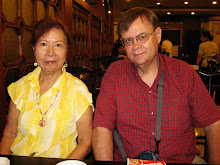
As stated in the previous post, all the "hard work" put in by the Freshmen Class 1 came to naught because we had not picked enough tea to process. I ended up with the tea we had picked. I took it home in hopes of convincing Sunee to become a tea processor. She liked the idea and we became our own specialists in tea processing. The above poster represents our new found field of tea processing. Actually it came from a website that specializes not in tea but in what is called "motivational posters." How is this for a motivational poster? The picture is mine as are the motivational words.
 I did some internet research and decided on a process known as the Longjing method. Basically there are three ways to process green tea: fry it, bake it or steam it.
I did some internet research and decided on a process known as the Longjing method. Basically there are three ways to process green tea: fry it, bake it or steam it. Since we have no oven to bake the tea in and we had no idea what steaming meant for tea, Sunee decided to fry it. The Longjing method calls for three separate fries of twenty minutes each. First, however, one had to let it dry in the shade for a couple of days. We followed these directions and you can see Sunee processing the tea in the first fry after the initial drying period.
 Here is the tea after the second frying. Sunee would fry the tea at medium heat and move it around the pan with her hands to insure all the tea was heated.
Here is the tea after the second frying. Sunee would fry the tea at medium heat and move it around the pan with her hands to insure all the tea was heated.
 After each frying, we would let the tea cool and "rest" the remainder of the day. The process took around five days with the first two days allowing the tea to dry on its own. Additionally, we allowed one day for each of the frying sessions for a total of five days.
After each frying, we would let the tea cool and "rest" the remainder of the day. The process took around five days with the first two days allowing the tea to dry on its own. Additionally, we allowed one day for each of the frying sessions for a total of five days.
 Here is the tea after the second frying. Sunee would fry the tea at medium heat and move it around the pan with her hands to insure all the tea was heated.
Here is the tea after the second frying. Sunee would fry the tea at medium heat and move it around the pan with her hands to insure all the tea was heated. After each frying, we would let the tea cool and "rest" the remainder of the day. The process took around five days with the first two days allowing the tea to dry on its own. Additionally, we allowed one day for each of the frying sessions for a total of five days.
After each frying, we would let the tea cool and "rest" the remainder of the day. The process took around five days with the first two days allowing the tea to dry on its own. Additionally, we allowed one day for each of the frying sessions for a total of five days. So how was this hand-picked, hand-processed China Tea Travels tea? To be honest, Sunee sneaked some to try after the second frying and she thought it was pretty good, so our expectations were high when I did the official tasting.

We used our Gaiwan teapot to make this first "official" unveiling of our own special green tea. As you can see, the tea came out a pale luscious and beautiful amber. The aroma was wonderfully hypnotizing with lots of hints of "hand-processing" and essence of being "hand-picked." Could it be that the freshmen all forgot to wash their hands as they picked our tea?Complex is simply a word that does not do justice to this "fantastic" tea.
As we both lingered over this exhilarating aroma, a hesitation gripped our solace. What if this stuff tastes bad? What if . . . .. . ? What if . . . . .? What the heck! We have just spent five days preparing for this moment and here we are hesitating.
As I sipped the hot liquid, the first thing that came to mind was . . . well, Zhuyeqing. Sunee's first comment was also - Zhuyeqing! Hey, that means that we were a success, doesn't it? A tea that tastes like Zhuyeqing is a good thing not a bad thing.
Actually this tea was quite good - not too bitter but with a nice sweetness that starts on the tip of the tongue and goes all the way back to the throat. It also possessed an aftertaste for a little longer than the normal Zhuyeqing. A very nice green tea, hand-picked and hand-processed on the slopes of Emei Mountain that screams out to anyone who dares sip of its youthfulness - I AM FRESH GREEN TEA.
Based on our experience as tea pickers and tea processors, are we ready for prime time? I think if one did the math, one would realize that tea from Emei can be bought for a whole lot less than the freshmen class paid for this tea. It cost 15 Yuan for each tea picker to go out and do the picking. There were 22 freshmen along with the Gap Guys and me doing the picking. The tea that Sunee and I, thus, processed cost an astounding 375 Yuan for less than 100 grams of processed tea. PRIME TIME? I think not.


No comments:
Post a Comment